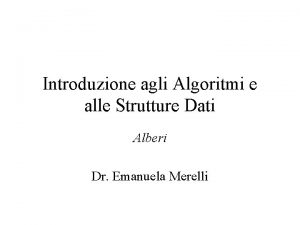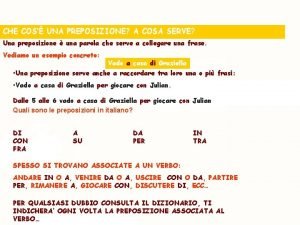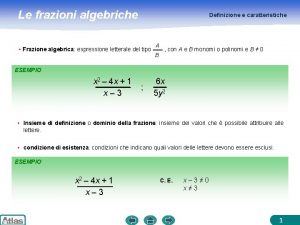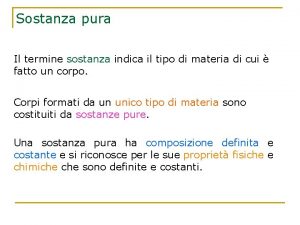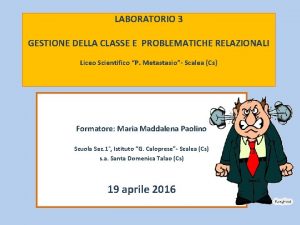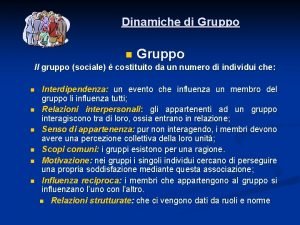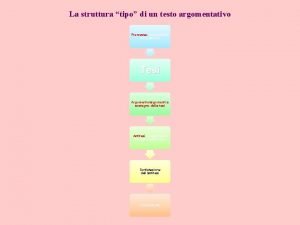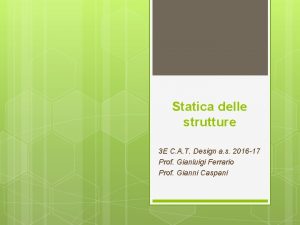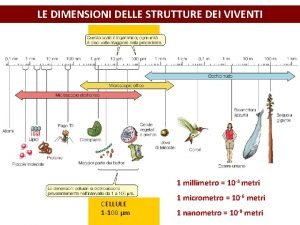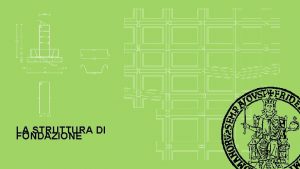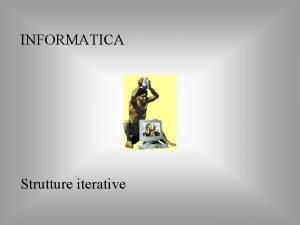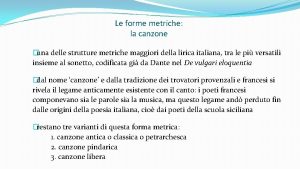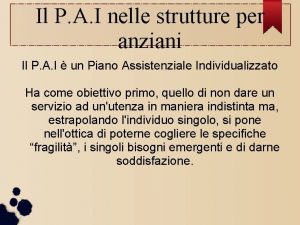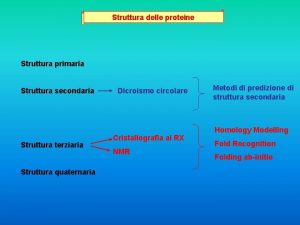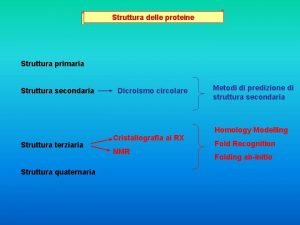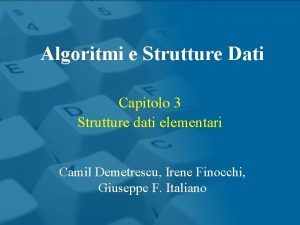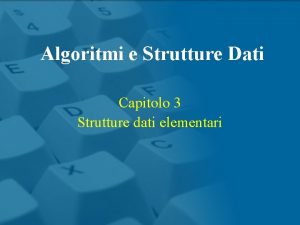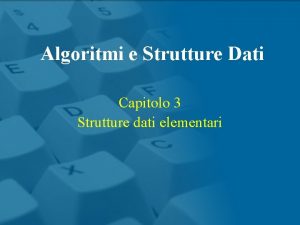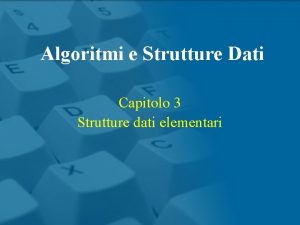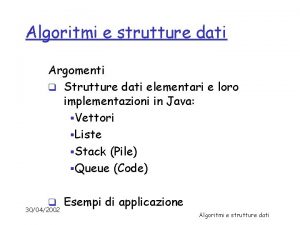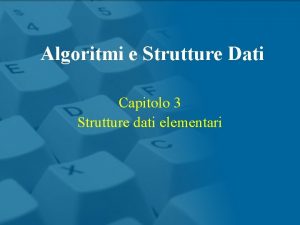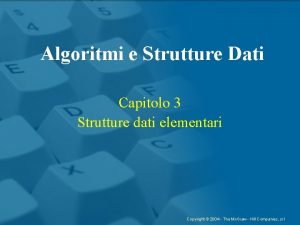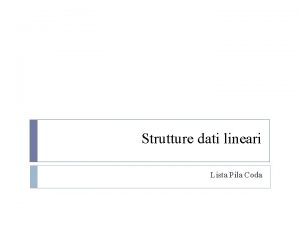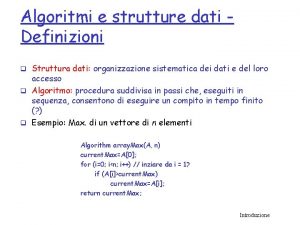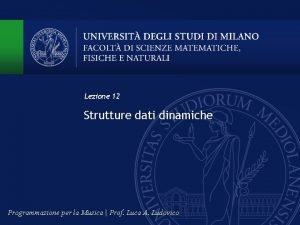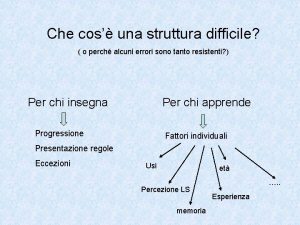Strutture Dati Dinamiche 1 Che cos una struttura



































- Slides: 35

Strutture Dati Dinamiche 1

Che cos’è una struttura dati • Per struttura dati si intende comunemente – la rappresentazione dei dati e – le operazioni consentite su tali dati • In linguaggi più evoluti del C esistono librerie di strutture dati – la Standard Template Library in C++ – le Collection in Java –… 2

Strutture dati più comuni • • • Lista concatenata (linked list) Pila (stack) Coda (queue) Insieme (set) Multi-insieme (multiset o bag) Mappa (map) Albero (tree) Grafo (graph) … 3

Lista Concatenata • Una vecchia conoscenza, ormai! typedef struct Nodo { Tipo dato; struct Nodo *next; } nodo; typedef nodo * lista; L'abbiamo già trattata come TDA 4

Pila (o stack) • È una struttura dati con accesso limitato all’elemento "in cima", che è quello inserito più recentemente (LIFO: last in, first out) • Nomi standard delle operazioni: – Push • Inserimento in cima – Pop • prelievo e rimozione dell’elemento in cima, che è per definizione l'ultimo elemento inserito – Top o Peek • Prelievo senza rimozione (cioè "sola lettura") dell'elemento in cima 5

Applicazioni della pila • Controllo di bilanciamento di simboli (parentesi, tag XML, blocchi C, …) – Per ogni simbolo di "apertura" si impila un segnaposto che sarà rimosso quando si incontra il simbolo duale di "chiusura" • Se il simbolo non corrisponde al segnaposto sulla pila, allora la sequenza non è bilanciata • Esempio: {[][{}[](){}]()}{[()]()}[{}] ok {[}{] ()} ko • Implementazione di chiamate a funzione – Pila di sistema e record di attivazione • Valutazione di espressioni aritmetiche 6

Pila (o stack): implementazione • PILA (stack): – I nuovi nodi possono essere aggiunti e cancellati solo dalla cima (top) della pila – La base della pila è indicata da un puntatore a NULL – È una versione vincolata della lista concatenata • push – Aggiunge un nuovo nodo alla cima della pila – Non restituisce nulla al chiamante (void) • pop – Cancella un nodo dalla cima della pila – Memorizza il valore cancellato – Restituisce un valore booleano al chiamante • true se l’operazione ha avuto successo 7

typedef struct s. Node { int data; struct s. Node * next. Ptr; } Stack. Node; typedef Stack. Node *Stack. Node. Ptr; void push( Stack. Node. Ptr *, int ); int pop( Stack. Node. Ptr * ); int is. Empty( Stack. Node. Ptr ); void print. Stack( Stack. Node. Ptr ); void instructions( void ); 8

int main() { Stack. Node. Ptr stack. Ptr = NULL; /* punta alla base (= alla cima!) della pila */ int choice, value; do { instructions(); scanf( "%d", &choice ); switch ( choice ) { case 1: printf( "Enter an integer: " ); /* caso push */ scanf( "%d", &value ); push( &stack. Ptr, value ); print. Stack( stack. Ptr ); break; case 2: if ( !is. Empty( stack. Ptr ) ) /* caso pop */ printf( "The popped value is %d. n", pop( &stack. Ptr ) ); print. Stack( stack. Ptr ); break; case 3: printf( "End of run. n" ); break; default: printf( "Invalid choice. nn" ); break; } } while ( choice != 3 ); return 0; } 9

void instructions( void ) { printf( "Enter choice: n"); printf( "1 to push a value on the stackn"); printf( "2 to pop a value off the stackn"); printf( "3 to end programnn> "); } void push( Stack. Node. Ptr *top. Ptr, int info ) { Stack. Node. Ptr new. Ptr; new. Ptr = malloc( sizeof( Stack. Node ) ); if ( new. Ptr != NULL ) { new. Ptr->data = info; new. Ptr->next. Ptr = *top. Ptr; *top. Ptr = new. Ptr; } else printf( "%d not inserted. No memory available. n", info ); } 10

int pop( Stack. Node. Ptr *top. Ptr ) { Stack. Node. Ptr temp. Ptr = *top. Ptr; int pop. Value = (*top. Ptr)->data; *top. Ptr = (*top. Ptr)->next. Ptr; free( temp. Ptr ); return pop. Value; } void print. Stack( Stack. Node. Ptr current. Ptr ) { if ( current. Ptr == NULL ) printf( "The stack is empty. nn" ); else { printf( "The stack is: n" ); while ( current. Ptr != NULL ) { printf( "%d --> ", current. Ptr->data ); current. Ptr = current. Ptr->next. Ptr; } printf( "NULLnn" ); } } int is. Empty( Stack. Node. Ptr top. Ptr ) { return top. Ptr == NULL; } 11

Coda (o queue) • In una coda l’accesso è ristretto all’elemento inserito meno recentemente (FIFO) • Le operazioni tipiche supportate dalla coda sono: – enqueue o offer • aggiunge un elemento in coda – dequeue o poll o remove • preleva e cancella l’elemento di testa – get. Front o peek • preleva ma non cancella l’elemento di testa 12

typedef struct q. Node { int data; struct q. Node *next. Ptr; } Queue. Node; typedef Queue. Node *Queue. Node. Ptr; void print. Queue( Queue. Node. Ptr ); int is. Empty( Queue. Node. Ptr ); int dequeue( Queue. Node. Ptr *, Queue. Node. Ptr * ); void enqueue( Queue. Node. Ptr *, int ); void instructions( void ); 14

int main() { Queue. Node. Ptr first. Ptr = NULL, last. Ptr = NULL; int choice, item; do { instructions(); scanf( "%d", &choice ); switch( choice ) { case 1: printf( "Enter an integer: " ); scanf( "n%d", &item ); enqueue(&first. Ptr, &last. Ptr, item ); print. Queue( first. Ptr ); break; case 2: if ( !is. Empty( first. Ptr ) ) { item = dequeue( &first. Ptr, &last. Ptr ); printf( "%d has been dequeued. n", item ); } print. Queue( first. Ptr ); break; case 3: printf( "End of run. n" ); break; default: printf( "Invalid choice. nn" ); break; } } while ( choice != 3 ); return 0; } 15

void instructions( void ) { printf ( "Enter your choice: n“ ); printf ( " 1 to add an item to the queuen" ); printf ( " 2 to remove an item from the queuen" ); printf ( " 3 to endnn> " ); } void enqueue( Queue. Node. Ptr *first. Ptr, Queue. Node. Ptr *last. Ptr, int value ) { Queue. Node. Ptr new. Ptr; new. Ptr = malloc( sizeof( Queue. Node ) ); if ( new. Ptr != NULL ) { new. Ptr->data = value; new. Ptr->next. Ptr = NULL; if ( is. Empty( *first. Ptr ) ) *first. Ptr = new. Ptr; else ( *last. Ptr )->next. Ptr = new. Ptr; *last. Ptr = new. Ptr; } else printf( "%c not inserted. No memory available. n", value); } 16

int dequeue( Queue. Node. Ptr *first. Ptr, Queue. Node. Ptr *last. Ptr ) { Queue. Node. Ptr temp. Ptr = *first. Ptr; int value = ( *first. Ptr )->data; *first. Ptr = ( *first. Ptr )->next. Ptr; if ( *first. Ptr == NULL ) *last. Ptr = NULL; free( temp. Ptr ); return value; } void print. Queue( Queue. Node. Ptr current. Ptr ) { if ( current. Ptr == NULL ) printf( "Queue is empty. nn" ); else { printf( "The queue is: n" ); while ( current. Ptr != NULL ) { printf( "%d --> ", current. Ptr->data ); current. Ptr = current. Ptr->next. Ptr; } printf( "NULLnn" ); } } int is. Empty( Queue. Node. Ptr first. Ptr ) { return fearst. Ptr == NULL; } 17

Insieme (o set) • È come la lista, ma con il vincolo di non ammettere valori duplicati • L’ordine in cui appaiono gli elementi nella lista è trasparente all’utente – Necessariamente, poiché non è significativo • Di solito, per motivi di convenienza, gli insiemi si realizzano tramite liste ordinate – Così si velocizzano le operazioni di ricerca (dicotomica / binary search) e inserimento 18

Prototipi per l’insieme • int add ( Tipo item, Insieme * i ); – aggiunge l’elemento dato all’insieme e restituisce un valore (booleano) che indica se l’operazione ha avuto successo • int remove ( Tipo item, Insieme * i ); – rimuove l’elemento indicato dall’insieme e restituisce un valore (booleano) che indica se l’operazione ha avuto successo • int contains ( Tipo item, Insieme i ); – verifica se l’elemento dato è presente nell’insieme (restituisce un valore booleano) 19

Albero binario • Un albero binario è una struttura dati dinamica in cui i nodi sono connessi tramite “rami” ad altri nodi in modo che: – c'è un nodo di partenza (la “radice”) – ogni nodo (tranne la radice) è collegato ad uno e un solo nodo “padre” – ogni nodo è collegato al massimo a due altri nodi, detti “figli” (max due binario) – i nodi che non hanno figli sono detti “foglie” 20

Struttura di un albero binario typedef struct Nodo { Tipo dato; struct Nodo *left; struct Nodo *right; } nodo; typedef nodo * tree; STRUTTURA RICORSIVA Un albero è un nodo da cui "spuntano" due… alberi! (l'albero destro e l'albero sinistro) 21

Piccoli esercizi su alberi binari NATURALMENTE in versione ricorsiva! Per capire quanto sia più semplice formulare questi problemi e le relative soluzioni in forma ricorsiva è sufficiente … provare a fare diversamente! Esercizi "facili": Conteggio dei nodi Calcolo della profondità Ricerca di un elemento Conteggio dei nodi foglia Conteggio dei nodi non-foglia Conteggio dei nodi su livello pari/dispari Un esercizio difficile: Verifica di "simmetria speculare" dell'albero: OK KO 22

Conteggio dei nodi int conta. Nodi ( tree t ) { if ( t == NULL ) return 0; else return (conta. Nodi(t->left) + conta. Nodi(t->right) + 1); /* c’è anche il nodo corrente */ } 23

Calcolo della profondità int depth ( tree t ) { int D, S; if (t == NULL) return 0; S = depth( t->left ); D = depth( t->right ); if ( S > D ) return S + 1; else return D + 1; } 24

Calcolo della profondità int max(int a, int b) { if(a>b) return a; else return b; } int depth ( tree t ) { if (t == NULL) return 0; return max(depth( t->left ), depth( t->right ))+1; } 25

Ancora la profondità (variante) int depth ( tree t, int current. Depth) { int D, S; if ( t == NULL ) return current. Depth; else { S = depth( t->left, current. Depth+1 ); D = depth( t->right, current. Depth+1 ); if ( S > D ) Questa versione utilizza il concetto "sussidiario" return S; di livello di profondità del nodo corrente, che è else incrementato di una unità ad ogni chiamata che scende "più in profondità" return D; } 26

Ricerca di un elemento in un albero Restituisce NULL se non trova nell’albero t il dato d, altrimenti restituisce il puntatore al primo nodo che lo contiene, effettuando la visita di t in preordine sinistro tree trova ( tree t, Tipo d) { tree temp; if ( t == NULL) return NULL if ( t->dato == d ) /* Se Tipo ammette l’operatore == */ return t; temp = trova( t->left, d ); if ( temp == NULL ) return trova( t->right, d ); else return temp; } 27

Ricerca di un elemento in un albero Restituisce NULL se non trova nell’albero t il dato d, altrimenti restituisce il puntatore al primo nodo che lo contiene, effettuando la visita di t in preordine sinistro tree trova ( tree t, Tipo d) { tree temp, temp 2; if ( t == NULL) return NULL if ( t->dato == d ) /* Se Tipo ammette l’operatore == */ return t; temp = trova( t->left, d ); temp 2 = trova( t->right, d ); if(temp 2!=NULL) retutn temp 2; else return temp; } 28

Numero di nodi foglia int leaves ( tree t ) { if ( t == NULL ) return 0; if ( t->left == NULL && t->right == NULL); return 1; return leaves( t->right ) + leaves(t->left); } 29

Numero di non-foglia int branches ( tree t ) { if ( t == NULL || ( t->left == NULL && t->right == NULL) ) return 0; return 1 + branches( t->right ) + branches(t->left); } oppure… int branches 2 ( tree t ) { return conta. Nodi( t ) – leaves( t ); } Si noti che la seconda versione scandisce due volte l'intero albero, impiegando circa il doppio del tempo (e lo stesso spazio in memoria) 30

Numero di nodi su livelli dispari int odd. Count ( tree t, int level ) { int n; if ( t == NULL ) return 0; n = odd. Count( t->left, level+1 ) + odd. Count( t->right, level+1 ); if ( level%2 == 1 ) /* == 0 per la funzione even. Count */ n++; return n; } Questa formulazione richiede che la prima chiamata abbia la forma: tree t = costruisci. Albero( … ); int x = odd. Count( t, 0 ); /* Considerando pari il livello della radice */ Per la funzione even. Count (nodi su livelli pari) si ragiona in modo perfettamente simmetrico, o si fa ancora conta. Nodi – odd. Count 31

Numero di nodi su livelli pari Consideriamo che il livello della radice sia pari. Possiamo scrivere una versione di even. Count che non necessita di propagare il concetto di livello "in avanti" nelle chiamate ricorsive. int even. Count ( tree t ) { int n = 1; /* Il nodo corrente è sempre su livello pari, per ipotesi induttiva*/ if ( t == NULL ) return 0; if ( t->left != NULL ) n += even. Count( t->left ) + even. Count( t->left->right ); if ( t->right != NULL ) n += even. Count( t->right->left ) + even. Count( t->right ); return n; } La prima chiamata sarà allora: tree t = costruisci. Albero( ? filename? ); int x = even. Count( t ); 32

Cancellare un albero void cancella(tree *t) { if (*t!=NULL) { if ((*t)->left != NULL) cancella(&((*t)->left)); if ((*t)->right != NULL) cancella(&((*t)->right)); free (*t); *t=NULL; } } 33

Componibilità delle strutture dati • • • Alberi di code Liste di liste Alberi di liste di code … Il “dato” contenuto nei nodi della struttura contenente è, in questi casi, una istanza di struttura dinamica del tipo che vogliamo sia il “contenuto” – del resto abbiamo sempre detto che il Tipo del contenuto dei nodi è assolutamente “libero” 34

Grafo • Un grafo è un insieme di vertici (o nodi) collegati da lati (o archi) • Può essere rappresentato, ad esempio, come la coppia dei due insiemi seguenti: – un insieme di vertici – un insieme di coppie di vertici (gli archi) 35

Albero n-ario • È una generalizzazione dell’albero binario – ogni nodo ha un numero arbitrario di figli • Può anche essere pensato come un grafo – Connesso • Cioè esiste un cammino di archi tra qualunque nodo e qualunque altro nodo nel grafo – Aciclico – Tale per cui • Ogni nodo (tranne uno, detto radice) ha un solo arco entrante • Si usa ad esempio per rappresentare tassonomie e organizzazioni gerarchiche 36
 Introduzione agli algoritmi e strutture dati
Introduzione agli algoritmi e strutture dati Cos'è una preposizione articolata
Cos'è una preposizione articolata Cos'è una congiunzione
Cos'è una congiunzione Divisione algebrica
Divisione algebrica Preposizioni improprie
Preposizioni improprie Cos'è la carta tematica
Cos'è la carta tematica Parafrasi corrispondenze
Parafrasi corrispondenze Sostanza pura definizione
Sostanza pura definizione Anafora figura retorica
Anafora figura retorica Rima speciale
Rima speciale Occorrenza di una base di dati
Occorrenza di una base di dati Gestione della classe e problematiche relazionali
Gestione della classe e problematiche relazionali Laboratorio inclusione sociale e dinamiche interculturali
Laboratorio inclusione sociale e dinamiche interculturali Dinamiche interculturali
Dinamiche interculturali Laboratorio gestione della classe e dinamiche relazionali
Laboratorio gestione della classe e dinamiche relazionali Dinamiche comportamentali
Dinamiche comportamentali Pagine web dinamiche
Pagine web dinamiche Inclusione sociale e dinamiche interculturali
Inclusione sociale e dinamiche interculturali Dinamiche di gruppo e leadership
Dinamiche di gruppo e leadership Dinamiche demografiche
Dinamiche demografiche Paradosso di sherman
Paradosso di sherman Frasi sulla testa dura
Frasi sulla testa dura Strutture logiche preformate
Strutture logiche preformate Strutture culturali
Strutture culturali Come individuare tesi e antitesi
Come individuare tesi e antitesi Dinamica delle strutture esercizi svolti
Dinamica delle strutture esercizi svolti Diafanizzazione istologia
Diafanizzazione istologia Struttura di fondazione diretta e indiretta
Struttura di fondazione diretta e indiretta Strutture iterative
Strutture iterative Il testo poetico e le figure retoriche
Il testo poetico e le figure retoriche Analisi non lineare delle strutture
Analisi non lineare delle strutture Strutture elementari tecnologia
Strutture elementari tecnologia Nova angeletta sovra l'ale accorta
Nova angeletta sovra l'ale accorta Pai strutture anziani
Pai strutture anziani Esempi di aziende con struttura funzionale
Esempi di aziende con struttura funzionale Esempio calcolo vento tettoia ntc 2018
Esempio calcolo vento tettoia ntc 2018
